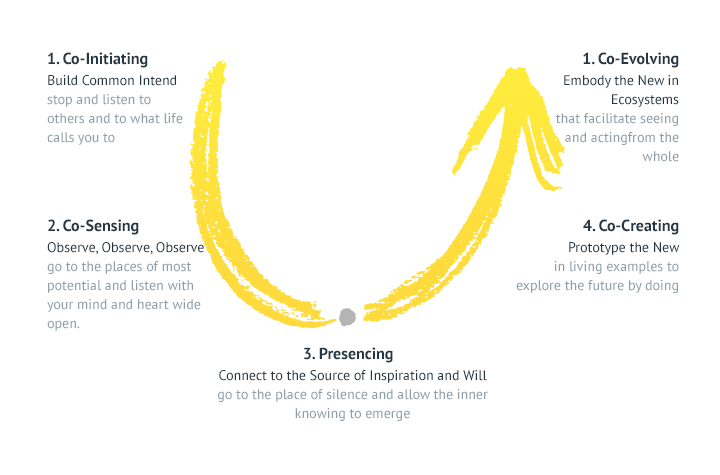What is Theory U ?
Tapping Our Collective Capacities
-----------------------
We live in a time of massive institutional failure, in which we collectively create results that nobody wants. The list is well known: Climate change. Hunger. Poverty. Terrorism. Violence. Destruction of communities, nature, life—the foundations of our social, economic, ecological, and spiritual well being. These times call for a new consciousness and a new collective leadership capacity to meet these challenges in a more conscious, intentional, and strategic way. The development of such a capacity would allow us to create a future of greater possibilities.
Illuminating the Blind Spot
-------------------------
Why do our attempts to deal with the challenges of our time so often fail? Why are we stuck in so many destructive patterns today? The cause of our collective failure is that we are blind to the deeper dimension of leadership and transformational change. This “blind spot” exists not only in our collective leadership but also in our everyday social interactions. We are blind to the source dimension from which effective leadership and social action come into being. We know a great deal about what leaders do and how they do it. But we know very little about the inner place, the source from which they operate. And it is this source that Theory U attempts to explore.
The U: One Process, Five Movements
----------------------------
As the diagram illustrates, we move down one side of the U (connecting us to the world that is outside of our institutional bubble) to the bottom of the U (connecting us to the world that emerges from within) and up the other side of the U (bringing forth the new into the world).
On that journey, at the bottom of the U, lies an inner gate that requires us to drop everything that isn’t essential. This process of letting-go (of our old ego and self) and letting-come (our highest future possibility: our Self) establishes a subtle connection to a deeper source of knowing. The essence of presencing is that these two selves—our current self and our best future Self—meet at the bottom of the U and begin to listen and resonate with each other.
Once a group crosses this subtle threshold, nothing remains the same. Individual members and the group as a whole begin to operate with a heightened level of energy and sense of future possibility. Often they then begin to function as an intentional vehicle for an emerging future.
Seven Theory U Leadership Capacities
----------------------------------
The journey through the U develops seven essential leadership capacities.
1. Holding the Space of Listening
The foundational capacity of the U is listening. Listening to others. Listening to oneself. And listening to what emerges from the collective. Effective listening requires the creation of open space in which others can contribute to the whole.
2. Observing
The capacity to suspend the “voice of judgment” is key to moving from projection to focused and peripheral observation.
3. Sensing
Seeing the system from the edges. The preparation for the experience at the bottom of the U requires the tuning of three inner instruments: the open mind, the open heart, and the open will. This opening process is an active “sensing” together as a group. While an open heart allows us to see a situation from the current whole, the open will enables us to begin to sense from the whole that is wanting to emerge.
4. Presencing
The capacity to connect to the deepest sources of self—to go to the inner place of stillness where knowing comes to surface.
5. Crystallizing
When a small group of change makers commit to a shared purpose, the power of their intention creates an energy field that attracts people, opportunities, and resources that make things happen. This core group and its container functions as a vehicle for the whole to manifest.
6. Prototyping
Moving down the left side of the U requires the group to open up and deal with the resistance of thought, emotion, and will; moving up the right side requires the integration of thinking, feeling, and will in the context of practical applications and learning by doing.
7. Co-Evolving
A prominent violinist once said that he couldn’t simply play his violin in Chartres cathedral; he had to “play” the entire space, what he called the “macro violin,” in order to do justice to both the space and the music. Likewise, organizations need to perform at this macro level: they need to convene the right sets of players in order to help them to co-sensing and co-create at the scale of the whole.
